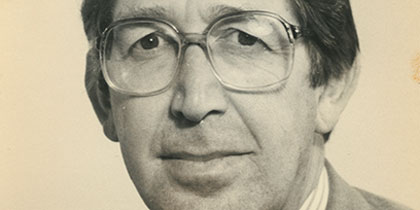
April 19, 2017, by Lindsay Brooke
Colleagues in Physics and Astronomy remember Professor Lawrie Challis OBE
Professor Laurence Eaves and Professor Tony Kent, in the School of Physics and Astronomy, at the University of Nottingham remember Professor Lawrence Challis. This obituary has been published by the Institute of Physics on MyIOP.
Lawrie Challis, who died on 24 March 2017, was an experimental physicist who did distinguished work at the University of Nottingham as a research scientist, administrator and inspirational teacher and lecturer over a period of more than 40 years.
Lawrence John Challis was born in September 1933 in Ramsgate, Kent. Following evacuation to Somerset during the Second World War, he studied at Chatham House Grammar School, Ramsgate where he excelled in science.
He gained a place at Merton College, Oxford in 1951, taking a first in honours physics in 1954. He then commenced his doctoral research work on low temperature physics at the Clarendon Laboratory, Oxford under the supervision of Dr John Wilks and supported by a Merton Senior Scholarship. The focus of this work was the so-called Kapitza resistance effect which determines the way in which heat is transferred between superfluid liquid helium and the surface of a solid at very low temperatures.
Having gained his Doctor of Philosophy degree, he was appointed lecturer in physics at the University of Nottingham in 1959. Throughout the 1960s he played a key role in developing Nottingham’s international reputation for research in experimental condensed matter physics; in recognition of this and his outstanding qualities as a lecturer and teacher he was appointed to an established Chair in Low Temperature Physics in 1979 and then to the Lancaster-Spencer Professorship in 1994.
Lawrie Challis’s profound insights into the way in which heat is conducted in metals and insulators led him to the idea of harnessing the quanta of thermal vibrations in solids to probe the electronic states of transition metal impurities in technologically important semiconductors and insulators. Much of his work was done in a fruitful collaboration with colleagues in Grenoble, France and led him to establish a series of annual “Gren-Nott” research meetings.
His appreciation of the importance of international research collaborations led to many other collaborations between Nottingham and researchers in western Europe, Russia and Japan. In the mid-1980s Nottingham physicists had the exciting opportunity to enter a new field of research on the electronic, optical and thermal properties of low- dimensional semiconductors, which was attracting worldwide interest. Lawrie Challis played a leading role in winning a major research council award to purchase a state- of-the-art system for growing these new semiconducting materials by molecular beam epitaxy (MBE) at Nottingham. The physics and technology of MBE-grown magnetic semiconductors and graphene remains a major research activity at Nottingham today.
During his distinguished career at Nottingham, Lawrie Challis took on major administrative responsibilities, serving as head of the Department of Physics from 1978 to 1981, dean of the science faculty in the late 1980s and pro vice-chancellor responsible for teaching quality, student services and international matters from 1995 to his retirement.
Using his characteristic diplomacy and patience while head of department, he was instrumental in ensuring that the department and university provided all necessary support in the early days of magnetic resonance imaging research in Nottingham, thus facilitating a clear path for the pioneering work which led the late Sir Peter Mansfield to share the 2003 Nobel Prize in Physiology or Medicine.
Outside the university, he served on many committees, including as chairman of the Royal Society Government Grant Board for Mathematics and Physics, chairman of the Institute of Physics Low Temperature Physics Group, chairman of the physics committees of the Science and Engineering Research Council, and board member of the European Physical Society.
Following his retirement in 1998, Lawrie Challis was appointed emeritus professor at Nottingham. He remained scientifically active, contributing to and editing a book, “Electron-phonon interactions in low-dimensional structures”, and collaborating with younger colleagues on several research projects.
In retirement, he also served as vice-chairman of the Independent Expert Group on Mobile Phones and Health and chair of the management committee of the UK Mobile Telecommunications and Health Research Programme, and published a well-regarded technical review on the way electromagnetic radiation interacts with biological material.
In recognition of his many research achievements Lawrie Challis was awarded the Holweck Medal and Prize of the UK Institute of Physics and the French Physical Society in 1994 and the Klemens Award of the International Phonon Physics Conference series in 1998. He was awarded an honorary degree from Liverpool John Moores University in 2005. In the 1996 New Year’s Honours List he was appointed Officer of the British Empire for services to scientific research.
Despite his many commitments at the University of Nottingham, Lawrie Challis championed the recognition of the Nottingham-based 19th century mathematical physicist and miller, George Green FRS. The work of Lawrie and his supporters helped to raise funds for the renovation of Green’s Windmill, which now dominates the skyline of east Nottingham, and for the establishment nearby of a science activity centre regularly visited by school children, aspiring young scientists and the general public. He also campaigned successfully for the installation of a plaque in Westminster Abbey commemorating the achievements of George Green.
Throughout his busy career, Lawrie Challis was a hospitable friend and adviser to his many students, research colleagues and foreign visitors. He and his wife Jennifer would regularly invite colleagues to parties at their home; Lawrie would frequently drive to Heathrow to collect overseas colleagues embarking on their first period of research in Nottingham.
During retirement Lawrie Challis found more time to enjoy walking in Devon and sailing his 19-foot Cornish crabber with his family and friends as crew. He is survived by his wife, Jennifer, and by their two children: Michael, who works in the oil industry, and Sue, who is a chemistry teacher.
No comments yet, fill out a comment to be the first

Leave a Reply